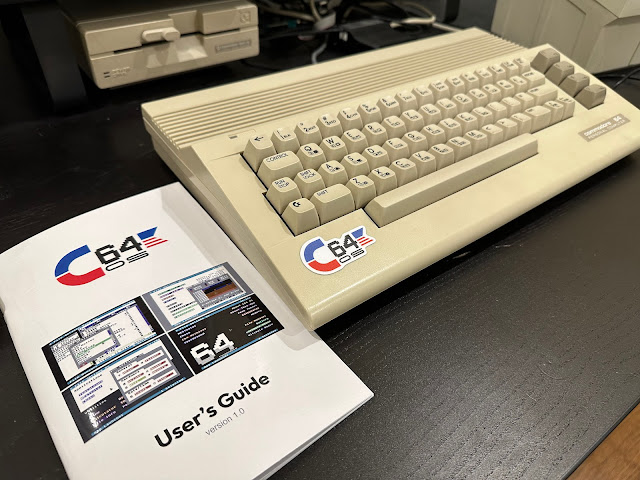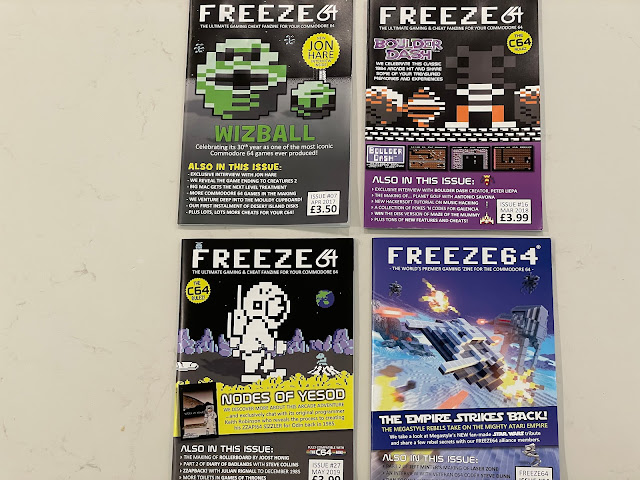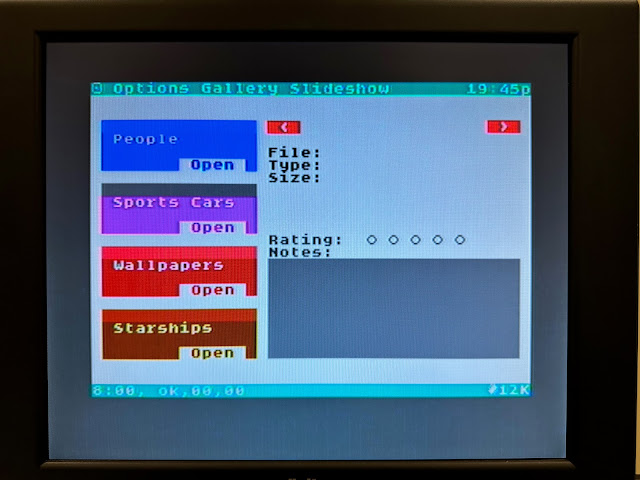For my final blog post of 2022, I decided to take a quick look at the recently released C64OS from OpCoders, a brand new operating system for the Commodore 64!

Yes, really. There is a brand new operating system for the Commodore 64 in 2022!
Back in the early 1980's, I learnt how to program on the C64, mainly in BASIC. But like a lot of kids my age, Commodore 64 was all about the amazing games and (later) the demoscene.
You turn the C64 on, and you get Microsoft BASIC with printing, modem, disk and tape loading functionality all started from BASIC. I never really thought about the C64 having an operating system as we know it today.
Go forward a few years and GEOS was released on the C64, which provided a nice graphical user interface on the C64, to run word processors, spreadsheets and more.
By this time I had moved onto the Amiga, so I didn't use GEOS much - I played with it at a friends house at the time. GEOS is spread over several disks, and was not released in a cartridge format so it could quickly boot on power on, and thus being *the* operating system you use. Never understood that.
I know there are a few other operating systems released on the C64, but I have never used any of them sorry, as I was heavily into Amiga by then.
Moving on to 2022, C64 OS is an attempt to create a new, fast operating system for the Commodore 64 with a unique user interface, which works with the 64K memory limitation of the C64. It has been in beta for a while now, and finally now reached V1.0 release and
available for purchase!
C64 OS comes on either a 16MB (Starter bundle) or 64MB SD Card (Standard bundle), which is designed for use with SD2IEC, IDE64, RAMlink and CMD based hard disk solutions. It costs Canadian CAD69 for the Standard bundle version I bought, plus taxes and shipping costs. Note that the cheaper Starter bundle is out of stock as I write this blog post.
Sadly C64 OS doesn't work with 1541 Ultimate II/+, Chameleon, or similar hardware. This presented a problem for me, as 1541 Ultimate II and Chameleon are my only virtual disk solutions on the Commodore 64. The full C64 OS hardware requirements are on their website
here.
I did some research and found a local seller in Australia who was selling a SD2IEC integrated into a Fast load combo cartridge. I liked the solution as it was simple, and it added the required Epyx Fastload function I would lose without the 1541 Ultimate II connected.
The SD2IEC Fastload Combo Cartridge solution I bought soon arrived, while I was still waiting for the C64 OS to arrive from overseas.
The Combo cartridge is in a 3D printed customised cartridge shell, obviously to fit the sd card slot, and the buttons around it. It doesn't look that great in black - there were other colours in the past, but all out of stock when I ordered it. So black it is!
Rear view, showing the SDCard slot, and the rear two buttons.
There was also a nice instruction sheet included, showing how to get started, and also how to change the Drive ID if you plan to use another disk drive at the same time.
Given the length of the cable included (which is the exact length needed to reach the port on the back of the C64), I would have thought it would be quite difficult to daisy chain this cartridge to a 1541 drive to be able to use both. I would like to though, but doesn't seem possible.
The reality is this cartridge will need to be removed and replaced with the Ultimate 1541 II when I want to use my real 1541 II floppy drive. (it is normally daisy chained through the 1541 II floppy drive)
If someone knows if it is possible to get an extension cable for the combo cartridge so I can daisy chain please let me know!
Next, I prepped the SD Card as per the instructions. as I use SD2IEC solution (with special custom connector) on my Commodore Plus/4 computer, I could copy that SD card, and just add the C64 software to it.
It looks pretty clean when I plugged it into the cartridge port.
On power on, I get the FASTLOAD prompt, telling me that Fastload is enabled for loading from disk.
I then loaded the FB menu program on the prepared SD Card so I could check the SD2IEC functionality works as expected.
The activity light on the top of the combo cartridge is a nice touch.
I loaded up the Wizball D64 floppy image using the SD2IEC combo cartridge and it works great.
At this point I lost a bit of time as I spent a few hours playing Wizball, one of my favourite games on the C64...couldn't resist. Would love to get the amazing Wizball C64 soundtrack on Vinyl LP one day...SID when used well is just so awesome for music :-)
Anyway, eventually the C64 OS package arrived, and I was keen to get to work with it.
The manual included is a quickstart User's Guide manual as below, and a sticker too.
The SD Card containing the C64 OS itself is attached to the inside cover.
The full manual is on the website, unfortunately not in an easy PDF format to download...you have to read it on the website.
Feedback for the author, I would love an option to purchase a hardcover/softcover full manual please.
First things first, I take the SD Card and back it up on my
Alienware Windows 11 PC, as recommended in the instructions. The install process changes the contents, so this step is a logical precaution!
That done, I put it back in the SD2IEC combo cartridge, and loaded the directory of the SD Card so I can open the setup process for the C64 OS.
While starting work on the setup work, I pulled out the soundtrack CD of Polar Bears in Space, a recent game I purchased for the Commodore 64, which was included in the box. I love that the CD label looks like a real record.
I then fired up the FM Towns, which is near the C64, so I could listen to the wonderful SID music from this C64 game while I worked on the setup of C64OS!
As an aside, I continue to support Commodore 64 game developers throughout 2022, buying a lot of new release boxed games for C64. It is great to continue to get new boxed games for C64 in 2022.
Getting a new C64 game with a Record purchase was really cool too:
Normally I only buy cartridge games on the C64, but now I have a real 1541-II floppy drive, I have picked up some titles that I couldn't get on cartridge (either sold out or not available)
We even have C64 magazines like Freeze 64 and the reborn Zzap 64 in 2022. How fantastic. Please try to support some or all these amazing efforts, as they keep supplying us with new release Commodore 64 software and magazines to enjoy still!
Anyway, let's get back to C64 OS.
I type in LOAD"C64OS", 8 to get started:
This launches the C64OS Setup tool:
I then agreed with the terms and conditions and opened up the user guide to follow the instructions carefully.
This part is quite important, as it sets the drive number for C64OS to use, which is set to whatever Drive number the SD2IEC is set to. In my case, this is 8. If I had daisy chained a real floppy drive with drive 8 on it, I would need to change the Drive number on the SD2IEC board, by opening the cartridge to change a jumper. I don't need to do this, so let's move on.
I chose a fresh installation, since this is the first time I am setting it up. The installation then proceeds with the setup and this takes quite a long time to complete, so definitely time for a coffee.
While waiting, I read through some more of the manual, getting familiar with the user interface of C64OS and some of the key concepts.
Eventually the installation completes.
At this point, I needed to power off, as the next steps in the manual didn't work until I did this.
Having the Mega 65's advanced BASIC command set has spoilt me. I forgot just how awful changing directories is on the C64. It is needed though to do the next step.
I can then run the configure tool, to choose the mouse input and other initial settings for the user interface of C64OS.
I walk through the questions the configure tool asks. Important one is the mouse - if you don't have a mouse, make sure to choose joystick to control the mouse pointer.
You then get the option to change the default keyboard shortcuts. I didn't change them, but it was useful to see what they are.
I have an Amiga mouse, but not a 1351 mouse (or a converter for one), so I needed to choose joystick here.
I used the default Go-Menu places configuration to start with. With that done, the configuration of C64OS is complete, and ready to try.
On boot of the c64, just
LOAD"C64OS", 8 and then
RUN to start it. It takes a short while to boot up C64OS. Fastload definitely helps.
I then get the C64OS Welcome main screen:
There are menu items
File,
Options and
Go are at the top in the title bar, along with the date/time on the right hand side. I use my joystick as the mouse to navigate and press fire on the option I want to select. I really want to get a 1351 mouse now...
Under the File Menu, you can see the options to change/save backdrops, Add aliases to programs on the SD card, to appear on the desktop, and copy and move functions too.
Under the Options menu, you can select everything on screen, get information about an application, adjust the colours on the screen, save the settings that you have altered, and Quit back to C64 Basic.
Under the last menu Go, you can change which desktop you are looking at! That's right, C64OS support multiple desktops, like Linux, MacOS and other modern operating systems! You can also launch the file manager from this menu.
If you click on the Drives App alias on the Desktop, you can choose the SD2IEC SD Card, or an actual floppy drive to view. You can also eject SD Cards from here. I don't have a real floppy drive attached to be able to test that (due to the cable length mentioned before). You can also Rescan if you have inserted a disk.
The Calculator App on C64OS is quite impressive too, with the usual scientific and standard calculator functions.
From the Themes App alias on the desktop, you can choose from a few standard themes available in C64OS, or customise your own.
Here is the custom theme option, where you can set as you want yourself.
Next I launched the Gallery App, and this really blew me away.
Included with C64OS is a number of different galleries based on
People, Sports Cars, Wallpapers and Starships.
I selected Sports cars, and it shows the picture information for the first of ten photos in this gallery.
The files are in a .koa format. I need to learn more about that so I can put my own pictures in here later!
If you move the mouse to the bottom status bar and drag it up, the picture then appears!
You can infinitely pull up/down the picture from the status bar section, showing the full picture or part of the picture information screen. Very impressive.
Moving to the next picture, it is a Lamborghini.
I learnt the keyboard shortcut to display full screen, without needing to drag the status bar up each time to see the picture.
I am so impressed with the Gallery app on C64OS. I really want to add my own pictures in here...
Next I moved onto launching the File Manager App.
I like the structure and layout of the file manager app.
It allows up to 4 tabs, each showing different locations, and able to copy between them too. Very nice.
If you double click on an item, if it associated to an App on C64OS, it can then open it also. There are some SID music files on here so I thought it would be able to play them.
Turns out it is not as simple as that - File Manager asks me what app to use to open the sid file, which means it is not associated to anything. I know that playback of sid files is tricky with an OS loaded also. I would like to know how to play these from C64OS though. The SID files are included so I assume there is a way to play them right?
I am looking forward to learning a whole lot more about this new exciting operating system for the Commodore 64. There is an excellent Youtube video here that covers some more of the customisation you can do in more detail than I have done here today. Hopefully I have given you a taste to whet your appetite to get it and find out for yourself!
I wanted to write more about C64OS, but I ran out of time, so that will have to wait for 2023!
2022 has been a great year, with a lot of amazing software and hardware released. I have tried to cover what I can in this blog this year, but there is a lot more out there to see! It is fun being able to cover all these new exciting developments for C64, Amiga and other platforms too. I have now been doing this blog for over 10 years!

I hope you have enjoyed my blog entries during the year.
Unfortunately, I have overseas work commitments in January and February, which means I will most likely see you all again on this blog in late February 2023.
Perhaps over the Xmas/New years break, is a good time to catch up on the hundreds of blog entries I have written since 2012!
In the meantime, stay safe, enjoy tinkering with all your computers, and I wish you all a very Merry Xmas and a Happy New Year! See you all in 2023.




























































